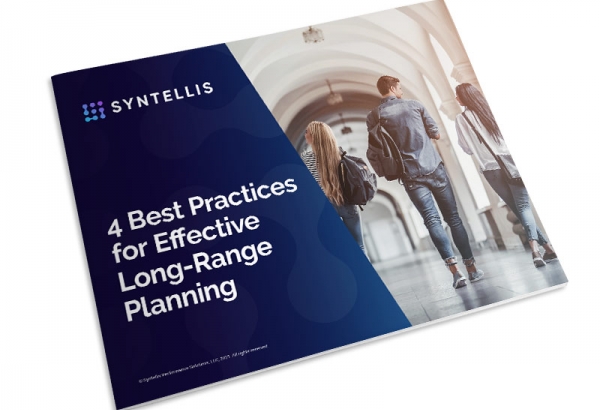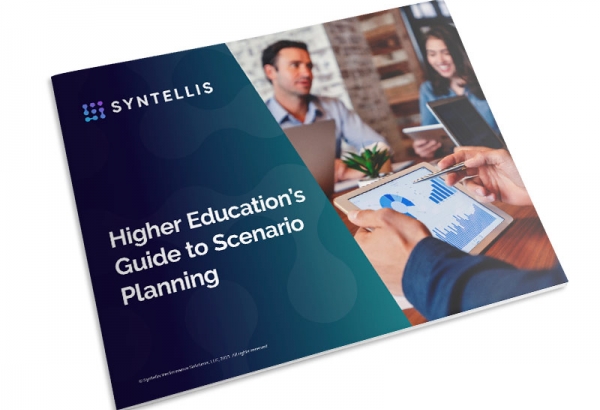To realize long-range plans, higher education institutions need to accurately predict how current decisions impact the future. A modern enterprise performance management (EPM) solution gives college and university finance teams the right scenario modeling tools to empower long-range planning, but they also need the right processes to aggregate disparate data to inform planning and decision-making.
Scenario modeling forms the foundation for long-range planning by mixing and matching drivers and initiatives to gauge the impact of assumptions against strategic plans. Using the status quo as the “base case,” institutions can evaluate how various initiatives will affect the scenario and apply new drivers that explore best, worst, and neutral impacts across different timeframes from one year to 10 years or more.
Consider the following must-have features of a modern long-range planning solution that encompasses scenario modeling:
- Comparing forward-looking models to current plans
- Accounting for all funds in models
- Measuring and monitoring key performance indicators (KPIs) and benchmarks
- Improving transparency to support decision-making
Comparing Forward-Looking Models to Current Plans
Financial modeling begins with the current budget or strategic plan. A mix-and-match approach to assumptions allows leaders to examine conservative and aggressive scenarios individually or in conjunction with other scenarios. Assumptions can include revenue increases or decreases, historical actuals, enrollment changes, economic factors, wages, interest rates, capital markets, and much more.
Long-range plans encompass a range of possible future states over several years that reflect assumptions, allowing leaders to understand the potential positive and negative financial impacts of any initiative or series of initiatives. For example, a new program may need a large initial investment and a time horizon of a few years before the investment results in higher enrollment and revenues. Modeling a new scenario should be as easy as changing inputs, running the report, and comparing it side-by-side with previous models in terms of impacts on the balance sheet, income statement and cash flow statement — which can be difficult when using spreadsheets.
Accounting for All Funds in Models
Long-range plans should include a full set of financial statements, including a GAAP-based statement of activities, balance sheet, and cash flow statements. Since decisions can affect how ratings agencies view an institution’s creditworthiness, rigor in long-range plans is critical.
The base case scenario should show an institution’s financial outlook for the next 5-10 years, given current trends and including all funds, debt capacity, capital plans, and cash flow. Initiatives are based on the strategic plan or required pivots, as occurred when the pandemic hit in spring 2020. Depending on the initiative, key drivers could include increased wage costs, additional revenues, new or reduced employee benefits, better classroom utilization, or changes in state appropriations.
Scenarios aggregate the various driver inputs to determine changes to the baseline scenario over a range of time periods. The analysis should include an income statement, balance sheet, cash flow projections, debt capacity, and key ratios. Multiple scenarios can be considered in tandem, with the ability to change drivers on the fly in response to questions, comments, new information, and other factors.
Measuring and Monitoring KPIs and Benchmarks
According to the Syntellis 2021 Higher Education Financial Technology Trends report, only half of colleges and universities currently use financial key performance indicators (KPIs), which lags other uses for KPIs, including enrollment (80%) and academic data (73%).
Among institutions that track and report financial KPIs, common data points encompass revenue/productivity, credit ratings agency, and administrative or academic cost benchmarks. Accessing reliable data can be difficult, as can creating reports that non-finance leaders can understand.
Long-range planning tools should roll up data from source systems (general ledger, student information system, etc.), combining that with economic, benchmarking, and credit agency data to create a full financial picture for stakeholders. Modern long-range planning tools visually demonstrate performance against benchmarks so leaders can better understand the impacts of today’s decisions over the next several years.
Improving Transparency to Support Decision-Making
Aggregating disparate data on a common platform, accounting for all funds, and including KPIs and benchmarks are critical factors to long-range planning success. Reporting functionality ties the other elements together to bring transparency and logic to decision-making, helping stakeholders understand changes over longer timespans than the annual budget.
Modern planning tools compare scenarios side by side to show the impact of each on cash flow, utilization, debt capacity, or any other metric — a feature that spreadsheets can’t emulate. Changing a scenario should be as easy as toggling drivers on or off and rerunning the scenarios. Look for a long-range planning solution that’s integrated and shares assumptions with budgeting and forecasting functionalities to bring efficiencies to planning processes.
Robust long-range planning solutions take much of the guesswork out of compiling and/or tweaking scenarios, leaving more time for finance leaders and governing boards to make critical business decisions that will position their institutions for continued success.
For more information on long-range planning for higher education, including examples of how leading institutions ensure their success, read the e-book: 4 Best Practices for Effective Long-Range Planning.
Read more on scenario modeling:

4 Best Practices for Long-Range Strategic Financial Planning

Higher Education’s Guide to Scenario Planning


